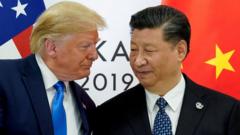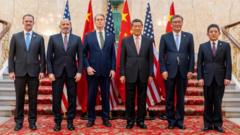As Malaysia seeks to enhance its semiconductor industry, particularly in high-tech chip manufacturing, evolving U.S. trade policies under President Trump present significant challenges.
### Malaysia’s Semiconductor Ambitions Threatened by U.S. Trade Policies

### Malaysia’s Semiconductor Ambitions Threatened by U.S. Trade Policies
The Southeast Asian nation's plan to advance in semiconductor production faces hurdles due to U.S. tariffs and trade regulations.
Malaysia, especially Penang, has long been a vital part of global tech supply chains, notably supplying semiconductors to the U.S. However, emerging tariffs raise questions about the future viability of its semiconductor ambitions, particularly in light of a strategic pivot towards chip design and advanced manufacturing.
In recent decades, Malaysia has become a key player in the semiconductor market, initially focusing on assembly and testing for significant American firms like Intel and AMD. The nation exports a substantial amount of its semiconductor products to the U.S., contributing significantly to its economy and generating numerous job opportunities.
Prime Minister Anwar Ibrahim's government aims to transition Malaysia from a labor-intensive assembly hub to a leader in semiconductor design and high-tech manufacturing, particularly in sectors related to artificial intelligence. The ambitious plan would see Malaysia investing billions over the next decade to develop capabilities akin to those of Taiwan, a rival powerhouse in semiconductor technology.
However, Malaysia's semiconductor aspirations now find themselves at the mercy of the U.S. administration's trade policies. President Trump has recently slapped tariffs on Malaysian exports, introducing a 24 percent levy on certain goods, which has created uncertainty in the industry. While the tariffs were temporarily paused, the situation remains fluid as negotiations continue.
Economist Julia Goh from UOB warns that a proposal for a blanket 25 percent tariff on all semiconductor imports looms over Malaysia's plans. With the U.S. aiming to bring semiconductor manufacturing back to its shores to enhance national security, Malaysia's ambitions could be severely compromised.
As the global tech landscape evolves, Malaysia will need to navigate these trade obstacles carefully to secure its place in the competitive semiconductor market and fulfill its goals in the age of A.I.
In recent decades, Malaysia has become a key player in the semiconductor market, initially focusing on assembly and testing for significant American firms like Intel and AMD. The nation exports a substantial amount of its semiconductor products to the U.S., contributing significantly to its economy and generating numerous job opportunities.
Prime Minister Anwar Ibrahim's government aims to transition Malaysia from a labor-intensive assembly hub to a leader in semiconductor design and high-tech manufacturing, particularly in sectors related to artificial intelligence. The ambitious plan would see Malaysia investing billions over the next decade to develop capabilities akin to those of Taiwan, a rival powerhouse in semiconductor technology.
However, Malaysia's semiconductor aspirations now find themselves at the mercy of the U.S. administration's trade policies. President Trump has recently slapped tariffs on Malaysian exports, introducing a 24 percent levy on certain goods, which has created uncertainty in the industry. While the tariffs were temporarily paused, the situation remains fluid as negotiations continue.
Economist Julia Goh from UOB warns that a proposal for a blanket 25 percent tariff on all semiconductor imports looms over Malaysia's plans. With the U.S. aiming to bring semiconductor manufacturing back to its shores to enhance national security, Malaysia's ambitions could be severely compromised.
As the global tech landscape evolves, Malaysia will need to navigate these trade obstacles carefully to secure its place in the competitive semiconductor market and fulfill its goals in the age of A.I.






















